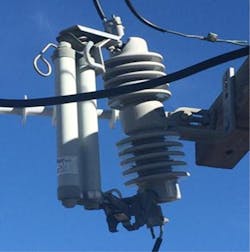CAL FIRE Guidelines Can Serve as Template for Utility Risk Management
Utilities the world over are strengthening distribution systems to reduce wildfire risk. Yet the reality is that updating T&D systems is a complex effort. Equipment manufacturers can help, specifically by designing and testing solutions in close coordination with the California Department of Forestry and Fire Prevention (CAL FIRE).
Preventing wildfires is a vital part of CAL FIRE’s focus. Although its guidelines may only directly apply to California utilities, it provides a relevant template for utility risk
management programs across North America.
Codes and Standards
The California Power Line Fire Prevention Field Guide outlines procedures to minimize the risk of catastrophic wildfires caused by electrical power lines and equipment. The field guide also details testing processes and a list of qualified equipment that meets CAL FIRE exemption requirements. According to the field guide, utilities can be exempt from these requirements only if they apply solutions approved by CAL FIRE to reduce wildfire risks.
Obtaining a product exemption from CAL FIRE is a major achievement. Manufacturers must follow rigorous testing procedures and demonstrate their products’ ability to operate while managing the energy to minimize the possibility of generating a wildfire.
An important aspect of reducing wildfire risk is deploying the right type of equipment.
Transformers and Laterals
In many parts of the U.S., expulsion fuses are used to clear fault currents. However, they pose a particular wildfire hazard with pole-type transformers and overhead laterals.
Current-limiting dropout fuses that have been granted permanent exemption by CAL FIRE from pole clearance requirements can help utilities to reduce risks (compared with traditional expulsion fuses) over large areas quickly. Exemption tests typically are performed at a utility test lab with a fire marshal in attendance, providing
third-party verification.
With these fuses, clearing both low-current and high-current faults is totally self-contained within the fuse housing. When a dropout fuse experiences a fault current, arcing across the internal spark gap melts the trigger wire and releases the dropout actuator. This causes the fuse to fall open in the cutout, providing a visible indication of fuse operation without any flammable byproducts.
Full-Range Fuses
Full-range, current-limiting fuses are alternatives to expulsion fuses used in a wide variety of aerial and ground-level distribution applications. From the minimum continuous current to the maximum interrupting rating, they can successfully interrupt any normal 60-cycle current that melts the fusible element.
Like current-limiting fuses, full-range fuses are designed to provide environmentally safe operation.
Some manufacturers’ full-range fuses do not require derating in elevated temperatures. For applications requiring higher load capacity, some full-range fuses can be used in parallel to double current ratings.
Bolster Overhead Distribution
Overhead distribution systems cover a lot of ground, much of which can be in dry or drought-stricken areas. Installing arresters that provide both surge and fire protection can help to reduce risk. These arresters efficiently isolate from the line and drastically reduce the risk of fire released during an end-of-life event. Additionally, they maintain power to downstream equipment.
Right-Sizing Solutions
There is no one-size-fits all approach to reducing wildfire risks. Eaton, for example, works with utilities on approaches that prioritize speed, added intelligence and cost efficiency. Adding CAL FIRE-exempt solutions is a critical step, and there are additional ways to strengthen the grid now and into the future.
For instance, advances in products designed to support underground power systems are becoming a more cost-effective option for some applications. In particular, solid dielectric switchgear enables utilities to move overhead lines underground in high-risk areas.
Adding intelligent grid automation schemes also can help to automatically and remotely isolate and manage impacted service areas following an event. Solutions like feeder automation software work with recloser controls to isolate the impacted areas of the grid and automatically reconfigure the system to reduce the scale of power outages.
Additionally, some manufacturers provide intelligent inventory management programs that help to provide fast supply of equipment to restore power. These programs monitor inventory levels before, during and after an emergency. Further, rapid-response storm-recovery services mobilize engineering resources within hours of a catastrophic event to coordinate a comprehensive plan for grid restoration.
Industry Collaboration
Developing effective wildfire mitigation strategies is a high priority for utilities around the globe. While local regulations and systems can differ greatly, the urgent need to mitigate risk remains constant. The electric utility industry is coming together to forge alliances and unify thinking to tackle these highly
complex problems.
Utilities across the U.S. are expanding and accelerating their wildfire prevention efforts and seeking solutions to strengthen the electric grid. As they do, CAL FIRE’s guidelines can serve as a template for utility risk management. In addition, many states and local municipalities are developing regional requirements.
Furthermore, investments in research and development to advance grid modernization and address wildfire threats are essential. Such research involving utilities, industry and government organizations, research labs and manufacturers is helping the industry by innovating, testing and deploying new approaches to complex challenges such as wildfire prevention.
Chris Decker is a product line manager at Eaton. He has worked with utilities for more than 20 years to help optimize the reliability and safety of overhead and
underground distribution systems.
About the Author
Chris Decker
Chris Decker is product line manager at Eaton.


